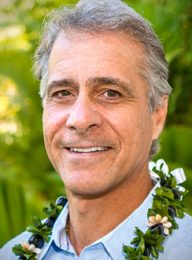
Increased enrollment, graduation rates, and research grants highlighted the remarkable resilience of University of Hawaiʻi at Mānoa faculty, staff and students as they successfully navigated an extremely challenging 2020, without compromising its core mission to provide a high-quality education. Despite the COVID-19 pandemic, UH’s flagship campus also updated its mission and vision statements and strategic goals to better position itself to serve its students and the people of Hawaiʻi for the coming decade and beyond.
Those were among the top takeaways of an annual presentation to the UH Board of Regents on February 18, 2021, by UH Mānoa Provost Michael Bruno, which featured presentations from the the leaders of Associated Students of UH, the Graduate Student Organization, the Mānoa Faculty Senate, and the Mānoa Staff Senate. The provost highlighted the significant strides made in the unprecedented year.
Updated mission, vision and strategic goals

Bruno started by outlining the updated mission of the campus to “cultivate creative and innovative leaders who mālama (care for) our people, our places and our ways of knowing in order to sustain and transform our islands and the world.” Guiding the future are four strategic goals: Becoming a Native Hawaiian Place of Learning (PDF), Student Success (PDF), Sustainability (PDF) and Research Excellence (PDF).
“The strategic goals include only four. That was intentional on the part of the committee, and really reflected the strong feedback we received from two years of discussions on campus,” Bruno said.
Academic units have begun the process of implementing the post-pandemic planning recommendations agreed upon after consultation with faculty, administrators and other key stakeholders. A spreadsheet lists every unit by school or college along with each unit’s list of recommendations, actions taken and actions completed. The spreadsheet will be updated regularly.
Increases in enrollment and graduation rates
Graduation rates continue to rise in a trend that started a decade ago that led to national recognition in 2017. In 2020, UH Mānoa saw increases in both the four-year (+1.3% to 61.8%) and six-year (+0.5% to 37.1%) graduation rates.
While nationally, most colleges and universities saw a decline in enrollment, UH Mānoa saw an increase in student enrollment in fall 2020. The overall enrollment climbed by 3%, and the number of first-generation students increased by 7%.
“As a first-generation student myself, I was really pleased to learn that we now have the capability to track our first-generation students and monitor how well we are doing in tracking and retaining those students,” Bruno said.
The number of Native Hawaiian students increased by 6.6% in the past year, bringing the total number of Native Hawaiian students to a record 17.7% of the campus enrollment.
Research continues to attract
UH Mānoa’s strong research programs continued an upward trend in 2020. The campus researchers brought in more extramural funding for a fourth-straight year. The $338 million in extramural funding was a record except for 2010 when stimulus funding supplemented the research.
UH Mānoa research funding:
- 2020: $338 million
- 2019: $314.5 million
- 2018: $301.1 million
- 2017: $294 million
Overall, UH Mānoa is one of only 95 public universities in the elite Carnegie R1 doctoral university category. The programs show they have been effective in spending those funds with disciplines such as ocean sciences and marine sciences ranking 4th out of 428 R1 research universities and geological and earth sciences hitting No. 14 in the same group.
One of the major success stories of the past two years was the increase in research opportunities for undergraduate students. The Undergraduate Research Opportunities Program (UROP) broadened its reach, providing a 37% increase in distribution of funds from $296,000 to $408,000 per year and a 59% increase in applications from 153 to 244.
Some challenges overcome, more challenges ahead
While not everything was perfect in a less than perfect year, employees rose to the challenge placed on the campus community. The number of cases in 2020 remained low compared to other similar-sized universities around the country.
Revenues were down in student housing and athletics because pandemic restrictions and precautions meant fewer student residents and the cancellation of some sports’ seasons.
“As vaccinations are more widely spread across our community, we can’t wait to get back on campus. I know that is true for our students, our faculty and our staff,” Bruno said. “But there are exciting opportunities that we are capitalizing on.”
Bruno said that teams are working to provide even more learning opportunities that will provide flexibility and expansion for improvements.

